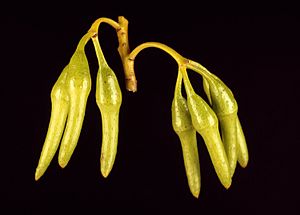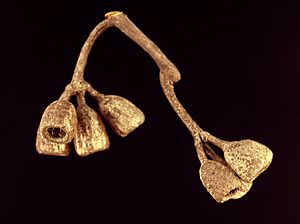Soak yate facts for kids
Quick facts for kids Soak yate |
|
|---|---|
 |
|
| Scientific classification | |
| Genus: |
Eucalyptus
|
| Species: |
aspratilis
|
The Eucalyptus aspratilis, often called the soak yate or inland mallee-yate, is a special type of mallee tree. It is found only in Western Australia. This tree has rough bark near its base. Higher up, its bark is smooth and silvery-grey. It has long, narrow adult leaves. Its flower buds hang down in groups of seven. The flowers are pale yellow or cream-colored. After flowering, it produces cylinder-shaped fruits.
Contents
What Does the Soak Yate Look Like?
The Eucalyptus aspratilis is a mallee. This means it's a type of eucalyptus that grows with many stems from the ground. It usually grows about 2 to 6 metres (6 to 20 feet) tall. Sometimes, it can reach up to 8 metres (26 feet). It also has a special woody swelling underground called a lignotuber. This helps the plant regrow after a fire.
The bark on the lower part of its trunks is rough and greyish-brown. It can look scaly or like ribbons. Higher up, the bark is smooth and silvery-grey. Sometimes, the smooth bark covers the whole tree.
Leaves and Flowers
Young plants and new shoots have egg-shaped or lance-shaped leaves. These leaves are about 2.5 to 7 centimetres (1 to 3 inches) long. They are dull bluish-grey. Adult leaves are glossy green on both sides. They are lance-shaped, about 5.5 to 10.5 centimetres (2 to 4 inches) long. These leaves grow on a stalk called a petiole, which is 0.7 to 2 centimetres (0.3 to 0.8 inches) long.
The flower buds usually grow in groups of seven. They appear where the leaves meet the stem, which is called the axil. These groups of buds hang from a stalk called a peduncle. This stalk is about 1.5 to 4.7 centimetres (0.6 to 1.9 inches) long. Each individual flower has its own small stalk, called a pedicel, about 0.4 to 0.8 centimetres (0.16 to 0.31 inches) long.
Mature buds hang downwards. They are long and spindle-shaped, a bit uneven. They measure about 2 to 3 centimetres (0.8 to 1.2 inches) long and 0.5 to 0.7 centimetres (0.2 to 0.3 inches) wide. Each bud has a horn-shaped cap called an operculum. This cap is two or three times longer than the base of the flower, which is called the floral cup.
Flowering and Fruit
The soak yate flowers from May to August. Its flowers are pale yellow to cream-colored, or sometimes yellowish-green.
After the flowers bloom, the tree produces fruit. The fruit is a woody, cylinder-shaped capsule. It is about 1 to 1.5 centimetres (0.4 to 0.6 inches) long and 0.7 to 1.2 centimetres (0.3 to 0.5 inches) wide. Inside the fruit are black to brown oval seeds. These seeds are very small, about 0.1 to 0.2 centimetres (0.04 to 0.08 inches) long.
How Did the Soak Yate Get Its Name?
The Eucalyptus aspratilis was officially described in 1993. This was done by two botanists, Lawrie Johnston and Ken Hill.
The second part of its scientific name, aspratilis, comes from a Latin word. It means "rough" or "scaly". This name refers to the rough bark found on the lower part of the tree's trunk.
Where Does the Soak Yate Grow?
The soak yate is found in specific areas of Western Australia. It grows near granite rock formations in the Great Southern and southern Goldfields-Esperance regions. It prefers sandy soils.
You can most commonly find this tree in an area between Coolgardie, south to Norseman, and west to Southern Cross.
Is the Soak Yate in Danger?
The Western Australian Government's Department of Parks and Wildlife has looked at the soak yate. They have classified it as "not threatened". This means it is not currently in danger of disappearing.



